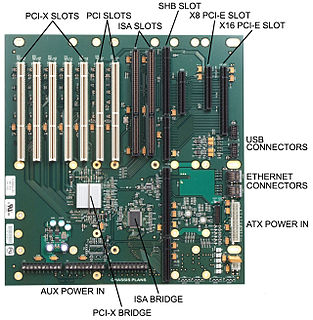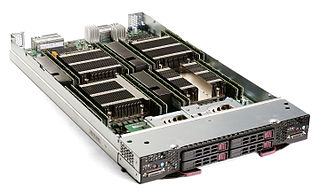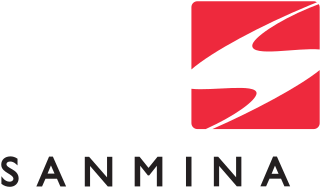
A backplane is a group of electrical connectors in parallel with each other, so that each pin of each connector is linked to the same relative pin of all the other connectors, forming a computer bus. It is used as a backbone to connect several printed circuit boards together to make up a complete computer system. Backplanes commonly use a printed circuit board, but wire-wrapped backplanes have also been used in minicomputers and high-reliability applications.

Eurocard is a European standard format for printed circuit board (PCB) cards that can be plugged together into a standard chassis which, in turn, can be mounted in a 19-inch rack. The chassis consists of a series of slotted card guides on the top and bottom, into which the cards are slid so they stand on end, like books on a shelf. At the spine of each card is one or more connectors which plug into mating connectors on a backplane that closes the rear of the chassis.

VMEbus is a computer bus standard, originally developed for the Motorola 68000 line of CPUs, but later widely used for many applications and standardized by the IEC as ANSI/IEEE 1014-1987. It is physically based on Eurocard sizes, mechanicals and connectors, but uses its own signalling system, which Eurocard does not define. It was first developed in 1981 and continues to see widespread use today.

A single-board computer (SBC) is a complete computer built on a single circuit board, with microprocessor(s), memory, input/output (I/O) and other features required of a functional computer. Single-board computers are commonly made as demonstration or development systems, for educational systems, or for use as embedded computer controllers. Many types of home computers or portable computers integrate all their functions onto a single printed circuit board.

Electronic test equipment is used to create signals and capture responses from electronic devices under test (DUTs). In this way, the proper operation of the DUT can be proven or faults in the device can be traced. Use of electronic test equipment is essential to any serious work on electronics systems.

CompactPCI is a computer bus interconnect for industrial computers, combining a Eurocard-type connector and PCI signaling and protocols. Boards are standardized to 3U or 6U sizes, and are typically interconnected via a passive backplane. The connector pin assignments are standardized by the PICMG US and PICMG Europe organizations. The connectors and the electrical rules allow for eight boards in a PCI segment. Multiple bus segments are allowed with bridges.

A blade server is a stripped-down server computer with a modular design optimized to minimize the use of physical space and energy. Blade servers have many components removed to save space, minimize power consumption and other considerations, while still having all the functional components to be considered a computer. Unlike a rack-mount server, a blade server fits inside a blade enclosure, which can hold multiple blade servers, providing services such as power, cooling, networking, various interconnects and management. Together, blades and the blade enclosure form a blade system, which may itself be rack-mounted. Different blade providers have differing principles regarding what to include in the blade itself, and in the blade system as a whole.
The PCI Industrial Computer Manufacturers Group (PICMG) is a consortium of over 150 companies. Founded in 1994, the group was originally formed to adapt PCI technology for use in high-performance telecommunications, military, and industrial computing applications, but its work has now grown to include newer technologies. PICMG is distinct from the similarly named and adjacently-focused PCI Special Interest Group (PCI-SIG).
Advanced Telecommunications Computing Architecture is the largest specification effort in the history of the PCI Industrial Computer Manufacturers Group (PICMG), with more than 100 companies participating. Known as AdvancedTCA, the official specification designation PICMG 3.x was ratified by the PICMG organization in December 2002. AdvancedTCA is targeted primarily to requirements for "carrier grade" communications equipment, but has recently expanded its reach into more ruggedized applications geared toward the military/aerospace industries as well. This series of specifications incorporates the latest trends in high speed interconnect technologies, next-generation processors, and improved Reliability, Availability and Serviceability (RAS).

Sanmina Corporation is an American electronics manufacturing services (EMS) provider headquartered in San Jose, California that serves original equipment manufacturers in communications and computer hardware fields. The firm has nearly 80 manufacturing sites, and is one of the world’s largest independent manufacturers of printed circuit boards and backplanes. As of 2022, it is ranked number 482 in the Fortune 500 list.
Advanced Mezzanine Cards are printed circuit boards (PCBs) that follow a specification of the PCI Industrial Computers Manufacturers Group (PICMG). Known as AdvancedMC or AMC, the official specification designation is AMC.x. Originally AMC was targeted to requirements for carrier grade communications equipment, but later used in other markets.

VPX, also known as VITA 46, refers to a set of standards for connecting components of a computer, commonly used by defense contractors. Some are ANSI standards such as ANSI/VITA 46.0–2019. VPX provides VMEbus-based systems with support for switched fabrics over a new high speed connector. Defined by the VMEbus International Trade Association (VITA) working group starting in 2003, it was first demonstrated in 2004, and became an ANSI standard in 2007.

ADLINK Technology Inc. is a company that designs and manufactures products for embedded computing, test and measurement, and automation applications. ADLINK's product line includes computer-on-modules, industrial motherboards, data acquisition modules and complete systems. Headquartered in Taiwan, ADLINK has operations in Beijing, Mannheim, Paris, San Jose, Seoul, Shanghai, Shenzhen, Singapore and Tokyo. ADLINK sells to original equipment manufacturers (OEMs) and system integrators.
CompactPCI Serial is an industrial standard for modular computer systems. It is based on the established PICMG 2.0 CompactPCI standard, which uses the parallel PCI bus for communication among a system's card components. In contrast to this, CompactPCI Serial uses only serial point-to-point connections. CompactPCI Serial was officially adopted by the PCI Industrial Computer Manufacturers Group PICMG as PICMG CPCI-S.0 CompactPCI Serial in March 2011. Its mechanical concept is based on the proven standards of IEEE 1101-1-1998 and IEEE 1101-10-1996. CompactPCI Serial includes different connectors that permit very high data rates. The new technology standard succeeding parallel CompactPCI comprises another specification called PICMG 2.30 CompactPCI PlusIO. This is why CompactPCI Serial and CompactPCI PlusIO as a whole were also called CompactPCI Plus. PICMG's first working title of CompactPCI Serial was CPLUS.0. CompactPCI Serial backplanes and chassis are developed by Schroff, Elmа, and Pixus Technologies companies, as for the CompactPCI Serial board level electronics – they are developed by MEN Mikro Elektronik, Fastwel, EKF, Emerson Embedded Computing, ADLINK, and Kontron.
Hybricon Corporation is a provider of systems packaging serving the military, aerospace, homeland security, medical and high-end Industrial markets and develops embedded computing systems using OpenVPX, VPX, VXS, VMEbus, VME64X, CompactPCI, rugged MicroTCA, and custom bus structures.

nVent SCHROFF GmbH is a German manufacturer of electronic packaging products. nVent SCHROFF products include cabinets, housings, chassis and related components for multiple markets such as telecommunications, data centers and traffic management. nVent SCHROFF GmbH is headquartered in Straubenhardt near Pforzheim, and was founded in 1962 by Gunther Schroff. It is now part of the UK-based company nVent Electric plc. nVent employs 9,000 people worldwide of which about 1,500 are part of the brand Schroff.
Acromag, Inc. manufactures embedded computing, process instrumentation, and distributed I/O products.

Modular crate electronics are a general type of electronics and support infrastructure commonly used for trigger electronics and data acquisition in particle detectors. These types of electronics are common in such detectors because all the electronic pathways are made by discrete physical cables connecting together logic blocks on the fronts of modules. This allows circuits to be designed, built, tested, and deployed very quickly as an experiment is being put together. Then the modules can all be removed and used again when the experiment is done.
Spectrum Signal Processing by Vecima is a technology company and commercial off-the-shelf (COTS) product provider, based in Vancouver, British Columbia. Spectrum designs and builds board and system-level hardware and software solutions for signal processing applications. Since May 2, 2007, Spectrum has operated as a division of Vecima Networks Inc., a Canadian technology company. In addition, Spectrum Signal Processing (USA), Inc. is a subsidiary of Vecima Networks Inc., and is primarily a sales organization for Spectrum's products in the United States.
MicroTCA is a modular, open standard, created and maintained by the PCI Industrial Computer Manufacturers Group (PICMG). It provides the electrical, mechanical, thermal and management specifications to create a switched fabric computer system, using Advanced Mezzanine Cards (AMC), connected directly to a backplane. MicroTCA is a descendant of the AdvancedTCA standard.












